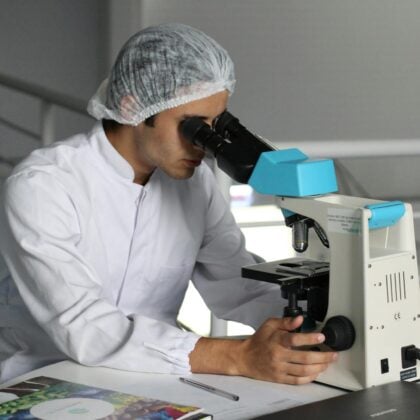
What is lactase?
Lactase or "lactase-phloridzin hydrolase" is an enzyme that belongs to the family of Beta Galactosidases A group of enzymes whose main function is to break down complex sugars into simple sugars.
Lactase is composed of more than 1900 amino acidsIt is excreted by the intestinal cells (enterocytes) into the digestive tract and its main role is to break down the lactosea type of disaccharide, into two simple sugars: glucose and galactose ; lactose is often called milk sugar because it is found mainly in cow's milk and dairy products (cheese, butter and yoghurt), and has the chemical formula C12 H22 O11.
This enzyme has an activity that varies over the course of a person's lifeIn the first half of life, it will be at its peak at birth and then slowly decrease during childhood as milk consumption decreases. Finally, it disappears almost completely in adults, although it remains active in a few people.
Lactose intolerance
Lactose intolerance is an abdominal syndrome marked by the appearance of acute abdominal pain, bloating and diarrhoea, sometimes vomiting especially in children, 30 minutes to 2 hours after ingestion of dairy products due to their high lactose content. The intensity of the symptoms depends on the amount ingested and the degree of lactase deficiency. Lactose intolerance may have no symptoms in some individuals.
Causes of lactose intolerance
Lactase deficiency is linked to 3 main causes:
- Partial and temporary deficit Gastroenteritis: often encountered in cases of intestinal mucosal damage such as viral and bacterial gastroenteritis, inflammatory bowel disease (Crohn's disease), malabsorption defects (coeliac disease) and irritable bowel syndrome.
- Total (congenital) deficiency : it begins at birth, the enterocytes do not have the capacity to synthesise lactase, the cause is genetic: genetic mutation of the LCT gene on chromosome 2 or transcription defect of the LCT gene, autosomal recessive mechanism.
- Ethnic and dietary deficits : In the majority of Asians and in some countries of equatorial Africa and South America, milk consumption is not part of their dietary habits, which hinders the excretion of lactase by the enterocytes. The severity of this deficiency is often remarkable in infants because breast or formula milk is the only source of nutrition for them before dietary diversification and the introduction of gluten-based foods from 6ème In the first few months of life, heavy diarrhoea can cause dehydration in the short term and even undernutrition in the medium term. These complications are dangerous and should be managed as soon as possible.
How is lactose intolerance diagnosed?
To confirm the diagnosis of lactose intolerance, several tests can be done:
- Blood glucose measurement after lactose intake Lactose tolerance test: this is a simple and quick test, the blood sugar level is measured at least 4 times during 03 hours after the ingestion of lactose; if the synthesis of lactase is deficient, the blood sugar level will not rise because the lactose will not be broken down into glucose. For diabetics, this test is not reliable enough because they have already high blood sugar levels.
- Hydrogen breath test lactose intolerance: this is the most commonly used test for the diagnosis of lactose intolerance, it is reliable and very specific After ingesting 10 g of lactose, the undigested lactose undergoes fermentation in the intestine, which causes a hyperproduction of hydrogen that is eliminated by the lungs; the measurement of exhaled hydrogen (the hydrogen that exits the lungs through the nose or mouth) is done over 3 successive hours. The presence of a high concentration of hydrogen in the breath means that lactase synthesis is deficient as most of the lactose will have been digested by colonic bacteria.
- Intestinal biopsy : In some cases, intestinal biopsy is necessary to test the response of the enterocytes to lactose by measuring lactase enzyme activity, if the lactose does not break down, the diagnosis of lactose intolerance will be made.
This test is invasive and is only done if the hydrogen breath test does not give satisfactory results.
Solutions and treatment
To reduce the symptoms of lactose intolerance, regular milk should be substituted with lactose-free milkEspecially for children and infants. Consumption of lactose-free dairy products is also recommended for adults; yoghurts enriched with lactase-producing bacteria (Lactobacillus acidophilus, Bifidobacterium, Streptococcus thermophilus) are useful for better digestion of lactose.
Lactolerance food supplements based on lactaseThese products help to reduce the digestive problems associated with lactose intolerance.
People who suffer from this syndrome should limit their consumption of dairy products provided they consume other sources of calcium and vitamin D such as fruit, vegetables, oilseeds and fish, to prevent bone demineralisation and the risk of fractures.

Hello, I'm Vincent
Like you, I'm lactose intolerantI know exactly what you're going through and the difficulties you encounter on a daily basis. For over 10 years, I've been helping our customers to use our dietary supplements and giving advice and tips on how to improve their digestive comfort. I'm also a keen cook and gourmet, so you'll find my favourite recipes for a lactose-free diet in this blog.
Lactose intolerance is not inevitable! With LACTOLERANCE you can digest with complete peace of mind






